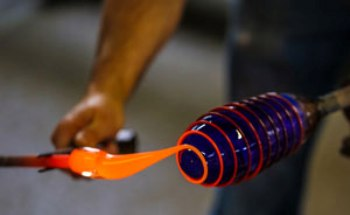May 18 2020
Four physicists from RIKEN have demonstrated the capability of an X-ray spectroscopy method to help understand the puzzling phenomena that take place when a liquid approaches a glass-like state.
 On cooling, glass changes from a liquid to a solid. Despite intensive research, many aspects of this transition remain unknown. A study by RIKEN researchers demonstrates the potential of X-ray photon correlation spectroscopy to provide new clues into glass transition. Image Credit: © John Lowe/EyeEm/Getty.
On cooling, glass changes from a liquid to a solid. Despite intensive research, many aspects of this transition remain unknown. A study by RIKEN researchers demonstrates the potential of X-ray photon correlation spectroscopy to provide new clues into glass transition. Image Credit: © John Lowe/EyeEm/Getty.
Upon cooling, several liquids experience a sharp transition at their freezing points, turning into crystalline solids. The most well-known example is water, which has a freezing point of 0 °C.
On the other hand, several liquid polymers and other materials undergo a more elegant transition called the glass transition. The solids they develop include structures nearer to a liquid’s random order compared to the ordered structure of crystalline solids such as metals and ice.
Glass is one such typical example—it exists in the solid-state at room temperature but its molecules are arranged in a disorganized way. There are several unresolved questions regarding the glass transition.
The phenomenon of glass transition is one of the biggest mysteries of soft-matter physics. Some scientists even question whether the glass transition is really a transition or if it just looks like one.
Taiki Hoshino, SPring-8 Center, RIKEN
One essential factor that might help solve the puzzles about the glass transition is the idea of dynamical heterogeneity—fluctuations in time and space in the local dynamic behavior of molecules.
Many researchers believe that the glass transition can be explained in terms of dynamical heterogeneity.
Taiki Hoshino, SPring-8 Center, RIKEN
In collaboration with three collaborators from RIKEN SPring-8 Center, Hoshino has utilized synchrotron-generated X-rays to measure dynamical heterogeneity in a liquid polymer near its glass-transition temperature.
To perform the measurements, the polymer was pressed between a moving substrate and a fixed cylindrical rod. The liquid closer to the substrate shifted quickly compared to the liquid nearer to the rod, leading to a velocity gradient throughout the liquid.
The researchers discovered that as the velocity gradient increases, the dynamical heterogeneity reduces. This validated the estimates of a molecular dynamics simulation reported over two decades earlier.
The scientists employed a method known as X-ray photon correlation spectroscopy (XPCS). Since all light waves forming a laser beam peak and trough synchronous to each other, the laser light scattered from an object produces a speckle pattern on a screen. XPCS makes use of the speckle pattern produced by X-rays to acquire data about a sample.
If the scatterers in the sample move, the scattering pattern changes. These fluctuations reveal information about the motion of the scatterers.
Taiki Hoshino, SPring-8 Center, RIKEN
Hoshino explained that XPCS has not gained much attention among the soft-matter physicists like other methods, but he believes that this study will reiterate its potential to others. “Our results show that XPCS is a powerful technique for studying glass transition,” said Hoshino.
Journal Reference:
Hoshino, T., et al. (2020) Dynamical Heterogeneity near Glass Transition Temperature under Shear Conditions. Physical Review Letters. doi.org/10.1103/PhysRevLett.124.118004.